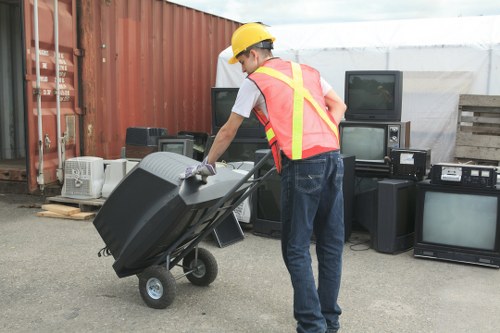Effective Furniture Disposal in Garbage London

Living in London comes with its unique challenges, especially when it comes to disposing of unwanted furniture. Whether you’re moving, renovating, or simply decluttering, knowing the best methods for furniture disposal can save you time, money, and the environment.
Furniture disposal in garbage London requires a strategic approach to ensure that items are discarded responsibly. Improper disposal can lead to fines and contribute to landfill waste, which is detrimental to the city’s efforts to maintain a clean and sustainable environment.
Understanding the different options available for getting rid of old furniture is crucial. From municipal services to private collection, each method has its advantages and considerations. This guide will explore the most effective ways to dispose of furniture in London’s urban setting.
Why Proper Furniture Disposal Matters

Proper furniture disposal goes beyond just removing unwanted items from your home. It plays a significant role in environmental conservation and public health. Here are some key reasons why it’s essential:
- Environmental Protection: Proper disposal ensures that materials are recycled or disposed of in an eco-friendly manner, reducing landfill waste.
- Legal Compliance: London has specific regulations regarding waste disposal. Non-compliance can result in hefty fines.
- Space Management: Efficient disposal frees up valuable space in your home or office, promoting a more organized and comfortable living environment.
By adhering to proper disposal methods, residents contribute to the collective effort of maintaining a cleaner and greener London.
Additionally, responsibly disposing of furniture can often lead to cost savings, especially if items can be reused or recycled.
Municipal Services for Furniture Disposal

London’s local councils offer various services to help residents dispose of furniture efficiently. These services are designed to be accessible and environmentally responsible.
One of the primary options is the bulky waste collection service. This allows residents to schedule a pickup for large items that cannot be placed in regular waste bins.
- Scheduling a Pickup: Most councils provide online booking systems where you can arrange for bulky waste collection at a convenient time.
- Accepted Items: Commonly accepted furniture items include sofas, tables, beds, and wardrobes. It’s essential to check with your local council for specific guidelines.
- Preparation Requirements: Items may need to be separated into different categories, such as electronics and textiles, to facilitate recycling and proper disposal.
Using municipal services ensures that your furniture is handled according to local regulations, promoting sustainability and reducing the environmental impact.
Private Collection Services

For those seeking more flexibility or immediate disposal, private collection services offer a convenient alternative. These companies specialize in furniture removal and often provide additional services beyond basic pickup.
Private services can be particularly beneficial for the following scenarios:
- Urgent Removals: If you need to dispose of furniture quickly, private companies can often accommodate same-day or next-day pickups.
- Specialized Handling: Items that are particularly large or fragile may require specialized handling, which private services can provide.
- Recycling and Donation: Many private companies prioritize recycling or donating usable furniture, contributing to a circular economy.
While private services may come at a cost, the added convenience and tailored services can make them a worthwhile investment for those needing efficient furniture disposal.
Recycling and Upcycling Options

Recycling and upcycling are sustainable alternatives to traditional furniture disposal. These methods not only reduce waste but also give old furniture a new lease on life.
Recycling involves breaking down furniture into its raw materials, which can then be reused in the production of new items. This process reduces the need for virgin materials and minimizes the environmental footprint.
- Wood Recycling: Wooden furniture can be shredded and repurposed for products like particleboard or mulch.
- Metal Recycling: Metal components from furniture can be melted down and reused in new manufacturing processes.
- Textile Recycling: Fabrics from upholstered furniture can be processed into new textiles or insulation materials.
Upcycling, on the other hand, involves creatively reusing old furniture to create something new and valuable. This can range from repainting and refurbishing pieces to transforming them into entirely different items.
By opting for recycling or upcycling, residents contribute to environmental sustainability while also potentially saving money and adding unique pieces to their living spaces.
Donation as a Furniture Disposal Method
Donating unwanted furniture is a commendable way to dispose of items while helping those in need. Several organizations and charities in London accept furniture donations, providing a second life for your belongings.
Here are some benefits of donating furniture:
- Supporting Communities: Donations can significantly impact individuals and families in need, providing essential items that improve their living conditions.
- Environmental Benefits: Donated furniture is often reused or refurbished, reducing the demand for new products and minimizing waste.
- Tax Deductions: In some cases, donations to registered charities may be tax-deductible, offering financial benefits to donors.
Before donating, ensure that the furniture is in good condition and that the organization accepts the items. Proper donation practices ensure that your contributions are meaningful and beneficial.
Moreover, some charities offer free pickup services, making the donation process even more convenient.
Responsible Disposal Practices
Responsible furniture disposal involves more than just getting rid of items. It requires a thoughtful approach to ensure minimal environmental impact and compliance with local regulations.
Assessing the Condition of Furniture
Before deciding on a disposal method, evaluate the condition of the furniture. Items that are still in good condition can be donated or sold, while those that are damaged may require recycling or proper landfill disposal.
Steps for Assessing Furniture
- Check for Usability: Determine if the furniture can be used as is or if minor repairs are needed.
- Identify Materials: Understanding the materials helps in choosing the appropriate disposal method.
- Consider Value: Even old furniture can have sentimental or monetary value, influencing the disposal choice.
Choosing the Right Disposal Method
Once you’ve assessed the furniture, select the most suitable disposal method. Factors to consider include the item’s condition, your budget, and the desired speed of disposal.
For example, if the furniture is in good condition, donating or selling might be the best option. However, if the item is broken or excessively worn, recycling or using municipal disposal services may be necessary.
Making an informed choice ensures that furniture disposal is handled efficiently and responsibly.
Legal Considerations for Furniture Disposal in London
Adhering to legal requirements is essential when disposing of furniture in London. The city has specific regulations aimed at minimizing waste and promoting recycling.
Key legal considerations include:
- Waste Classification: Understanding how your furniture is classified under local waste management laws.
- Permitted Disposal Methods: Knowing which disposal methods are legally allowed and recommended.
- Avoiding Illegal Dumping: Ensuring that furniture is not disposed of illegally, which can result in fines and environmental harm.
Staying informed about local laws and guidelines helps prevent unintentional violations and supports the city’s sustainability initiatives.
Consulting with local councils or waste management authorities can provide clarity on acceptable practices.
Eco-Friendly Disposal Options

Eco-friendly disposal options prioritize sustainability and reduce environmental impact. These methods align with London’s initiatives to create a greener city.
Some eco-friendly disposal practices include:
- Recycling: As previously mentioned, recycling breaks down materials for reuse.
- Upcycling: Transforming old furniture into new, functional items.
- Composting: For wooden items, certain components can be composted if they are untreated and free from hazardous materials.
Implementing eco-friendly disposal methods not only benefits the environment but also supports the city’s broader sustainability goals.
Moreover, these practices can often be more cost-effective and offer tax benefits in some cases.
Cost-Effective Furniture Disposal Strategies
Disposing of furniture doesn’t have to be expensive. Several strategies can help you manage costs while ensuring responsible disposal.
Here are some cost-effective methods:
- Utilize Free Municipal Services: Many London councils offer free bulky waste collection, reducing the need for private services.
- Sell or Give Away: Platforms like Craigslist, Freecycle, or local community boards allow you to sell or give away furniture without any costs.
- DIY Recycling: If possible, disassemble furniture and recycle materials yourself to save on processing fees.
By exploring these options, you can find economical ways to dispose of furniture without compromising on responsibility.
Additionally, some charitable organizations may offer free pickup services, adding to the cost-saving measures.
Best Practices for Preparing Furniture for Disposal
Proper preparation of furniture before disposal ensures a smooth and efficient process. Follow these best practices to make your furniture ready for disposal:
Cleaning and Repairing
Clean the furniture to remove any dirt or stains. Minor repairs can increase the value if you’re selling or donating.
Disassembling Large Items
For large pieces, consider disassembling them to make transportation easier. Keep screws, bolts, and other small parts in labeled bags to avoid losing them.
Removing Hazardous Materials
Ensure that any hazardous materials, like paints or solvents, are removed and disposed of separately according to local regulations.
Choosing a Reliable Disposal Service
Selecting a trustworthy disposal service is crucial for ensuring that your furniture is handled responsibly and efficiently.
Consider the following when choosing a service:
- Reputation: Look for services with positive reviews and a track record of reliable service.
- Certification: Ensure the company is certified and adheres to local disposal regulations.
- Services Offered: Check if the service offers recycling, donation, or upcycling options based on your needs.
Taking the time to research and select a reputable disposal service can provide peace of mind and ensure that your furniture disposal aligns with your values and requirements.
Additionally, transparent pricing and clear communication are indicators of a reliable service provider.
Frequently Asked Questions (FAQ)
Addressing common questions can help clarify the furniture disposal process in London.
What can be disposed of through London’s bulky waste collection?
Most large furniture items like sofas, beds, dining tables, and wardrobes are accepted. However, items containing electronics or hazardous materials may have specific disposal requirements.
Are there any fees associated with municipal furniture disposal?
Many London councils offer free bulky waste collection, but some may charge a fee depending on the service or item type. It’s best to check with your local council for specific details.
How do I schedule a furniture pickup?
Most councils provide online booking systems where you can schedule a pickup. Alternatively, you can contact them via phone or visit their local offices for assistance.
Can I recycle all types of furniture?
While many types can be recycled, some materials may require specialized recycling processes. It’s important to separate materials and consult with recycling services for proper handling.
Conclusion
Furniture disposal in garbage London is a manageable task with the right knowledge and resources. By exploring municipal services, private collection options, recycling, upcycling, and donation, residents can dispose of unwanted furniture responsibly and efficiently.
Adhering to legal regulations and adopting eco-friendly practices not only benefits the environment but also supports the city’s sustainability goals. Implementing cost-effective strategies and preparing furniture properly ensures a seamless disposal process.
Whether you’re decluttering your home or moving to a new location, understanding the best methods for furniture disposal in London empowers you to make informed and responsible decisions.
Contact us today to learn more about efficient furniture disposal services and take the first step towards a cleaner, greener space.
Frequently Asked Questions
Discover effective strategies for furniture disposal in London, including municipal services, private collections, recycling, upcycling, and donations. Learn best practices and legal considerations for responsible disposal.
Get In Touch With Us.
Please fill out the form below to send us an email and we will get back to you as soon as possible.